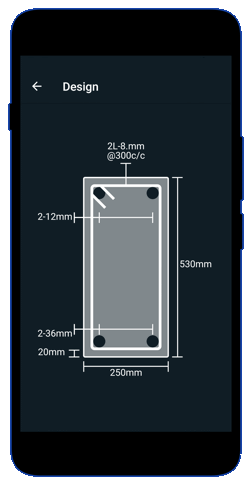To start the design of doubly reinforced beam you should have an idea about this type of section. As the name implies, in this type of beam section, we are providing the steel in both zones. In the case of a beam, the zone is basically compression and tension zone.
They are used in construction projects that require high load – bearing , such as bridges, high – rise buildings. These beams allows for more efficient use of materials, as the additional steel provides added strength without the need for a larger c/s area. This can save on materials and construction costs. Furthermore, these beams are a practical solution for old structures, as they can be added to beams to increase their load bearing.
Check this post to know more about a doubly reinforced beam section.
The design procedure of each beam is different only the underlying principle is the same. In this post I will explain about the step by step procedure of design of a beam, by considering an example problem.
Problem Statement: Design a doubly reinforced beam and use M20 concrete and Fe415 steel. End condition: two span continuous beam with equal spans. Ends are simply supported and span $L = 5 m $
Trial Section:
Assume cross section of the beam $230 mm \times 380 mm, d = 340 mm, d’ = 40 mm, $D_f = 130 mm $.
Compute Maximum load :
$$
w_{u \max }=1.5(D L+L L)=1.5(\text { self weight+ slab1 }+\text { slab2})
$$
$$
\begin{aligned}
& w_{u \cdot \max }=1.5[1.6+0.55 \times 6.5 \times 4+0.6 \times 6.5 \times 4.5 \times 0.73]=43 \mathrm{kN} / \mathrm{m} \\
& w_{u \cdot \min }=D L=[1.6+0.55 \times 5 \times 4+0.6 \times 5.0 \times 4.5 \times 0.73]=22.4 \mathrm{kN} / \mathrm{m} .
\end{aligned}
$$
Analysis of beam
Design Moment at support as well as at mid- span $= \pm w_u L^2 / 10$
$$
M_{u.max } =43 \times 5^2 / 10 = 107.5 \mathrm{kN} \cdot \mathrm{m}
$$
$$
M_{\max } = 0.8 \times 134.4 \text{This corresponds to 20} \% \text{redistribution of moment}
$$
$$k_{u .limit} = 0.6- 0.2 = 0.4, x_{u. limit} = 0.4 \times 340 = 136 mm$$
For this,
$$
\begin{aligned}
M_{\text { ur. limit }} & =0.36 \times 20 \times 0.4 \times(1-0.42 \times 0.4) \times 230 \times 340^2 \times 10^{-6} \\
& =63.7 \mathrm{kN} . \mathrm{m}<107.5 \mathrm{kN} . \mathrm{m}
\end{aligned}
$$
$$M_{ u2} = 107.5 -63.7 =43.8 kNm$$
Main Steel
$$
\begin{aligned}
& A_{st1}=\frac{63.7 \times 10^6}{ 0.87 \times 415 \times(340-0.42 \times 136)}= 624 \mathrm{~mm}^2 \\
& A_{st2}=\frac{43.8 \times 10^6}{ 0.87 \times 415 \times(340-40)}=404 \mathrm{~mm}^2 \\
& \therefore A_{st} =A_{st1 }+A_{ st2 } = 624+ 404 = 1028 \mathrm{~mm}^2
\end{aligned}
$$
$d_c/d = 40 / 340 = 0.117, A_{sc} = 1.063 \times 404 = 430 mm^2 $
At mid span
$$M_{u \cdot \max }=107.5 \mathrm{kN} . \mathrm{m}>M_{u r \cdot \max }=73.38 \mathrm{kN} . \mathrm{m}\left(=2.76 \times 230 \times 0.34^2\right)$$
Therefore, assistance will have to be taken of the flange.
$$
L_o \quad=0.7 L=0.7 \times 5000= 3500 \mathrm{~mm}
$$
$$
b_f \quad=(3500 / 6+6 \times 130)+ 230= 1593 \mathrm{~mm}
$$
When $x_u = D_f$,
$$ M_{ur} = 0.36 \times 20 \times 1593 \times 130 \times (340 – 0.42 \times 150) \times 10^{-6} \\ = 425 kN.m > M_{u.max}( = 107.5 kN.m) \therefore x_u < D_f$$
$$
A_{s t}=\frac{0.5 \times 20}{415}\left[1-\sqrt{1-\frac{4.6 \times 107.5 \times 10^6}{20 \times 1593 \times 340^2}}\right] \times 1593 \times 340=908 \mathrm{~mm}^2
$$
Detailing:
| Required A_{st} in mm^2 | Simple support | At mid-span | At Continuous end |
| At top At bottom | —— —— | —— 908 | 1028 430 |
| No. dia at top No. dia at bottom | 2 # 10 3 # 20 | 2 #10 3 #20 | 2 #10 + 3 #20 2 #20 |
| Provided $A_{st}$ at top $A_{st}$ at bottom | 157 942 | 157 942 | 1099 628 |
Conclusions
In this blog post, we have delved into a practical problem that provides an explanation of a DRB. As per IS:456:2000, Indian Standards, we have designed a R.C.C beam section.
So, let us discuss the key points from this problem as follows:
- Significance of Design and Analysis: It gives the need to consider various factors, including load distribution, to ensure the function of a beam.
- Consideration of Critical Factors: Throughout our design procedure, we have discussed significant factors such as bending moments, reinforcement, and deflection limits.
- Integration of Theory and Practice: All in one, by following the reinforcement detailing guidelines as per Indian codes, engineers can develop structurally sound and efficient solutions that meet safety and performance criteria.
Beam design
- RCC Beam Design is a free app for designing reinforced concrete beams as per Indian Standards.
- RCC Design and detailing could be performed by Limit State Method specified in IS456:2000
- Option to save the design projects in local storage.
- Detailed calculation steps presented for verification and validation.

This article was crafted by a group of experts at eigenplus to ensure it adheres to our strict quality standards. The individuals who contributed to this article are:
Author


